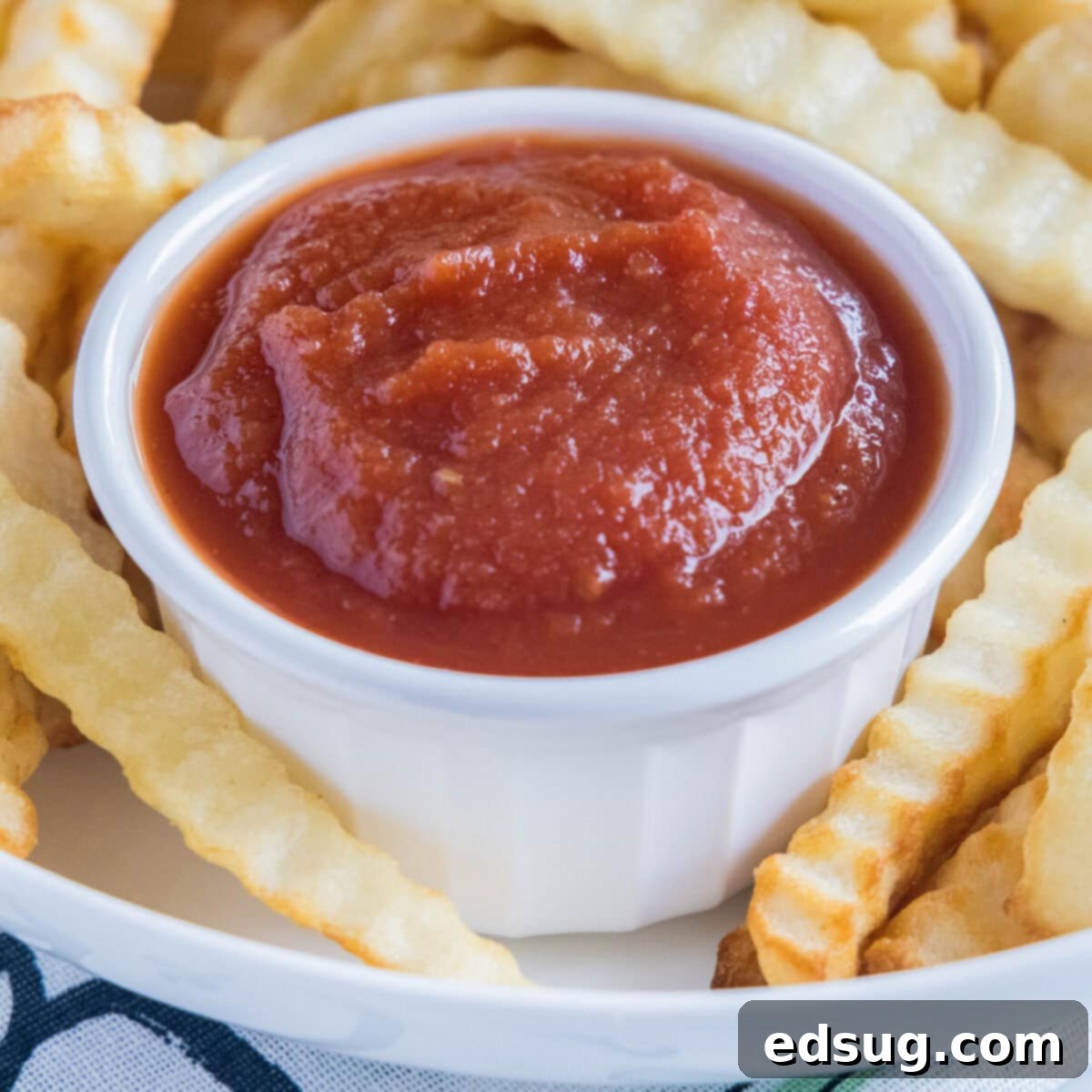Homemade Ketchup: Crafting the Perfect Tangy, Sweet, and Flavorful Condiment from Scratch
There’s an undeniable joy that comes from making your own food from scratch, especially when it comes to beloved condiments. This **homemade ketchup** recipe is a game-changer, offering a depth of flavor and a level of freshness that store-bought varieties simply can’t match. If you’re like me, your refrigerator is probably a treasure trove of various dips, sauces, and spreads. And through countless culinary experiments, I’ve discovered a golden rule: almost every sauce reaches its peak perfection when you craft it yourself. That’s precisely why this homemade ketchup has earned a permanent spot in my rotation of go-to recipes.
Forget the bland, overly sweet, or one-dimensional ketchups you find on supermarket shelves. This recipe delivers a robust tomato flavor, perfectly balanced with just the right amount of sweetness and a pleasant, bright acidity. It gets a subtle, intriguing kick from a thoughtful blend of pepper, garlic, and onion, all culminating in an incredibly smooth, velvety texture that will elevate any dish. I genuinely believe it’s far superior to anything you can buy.
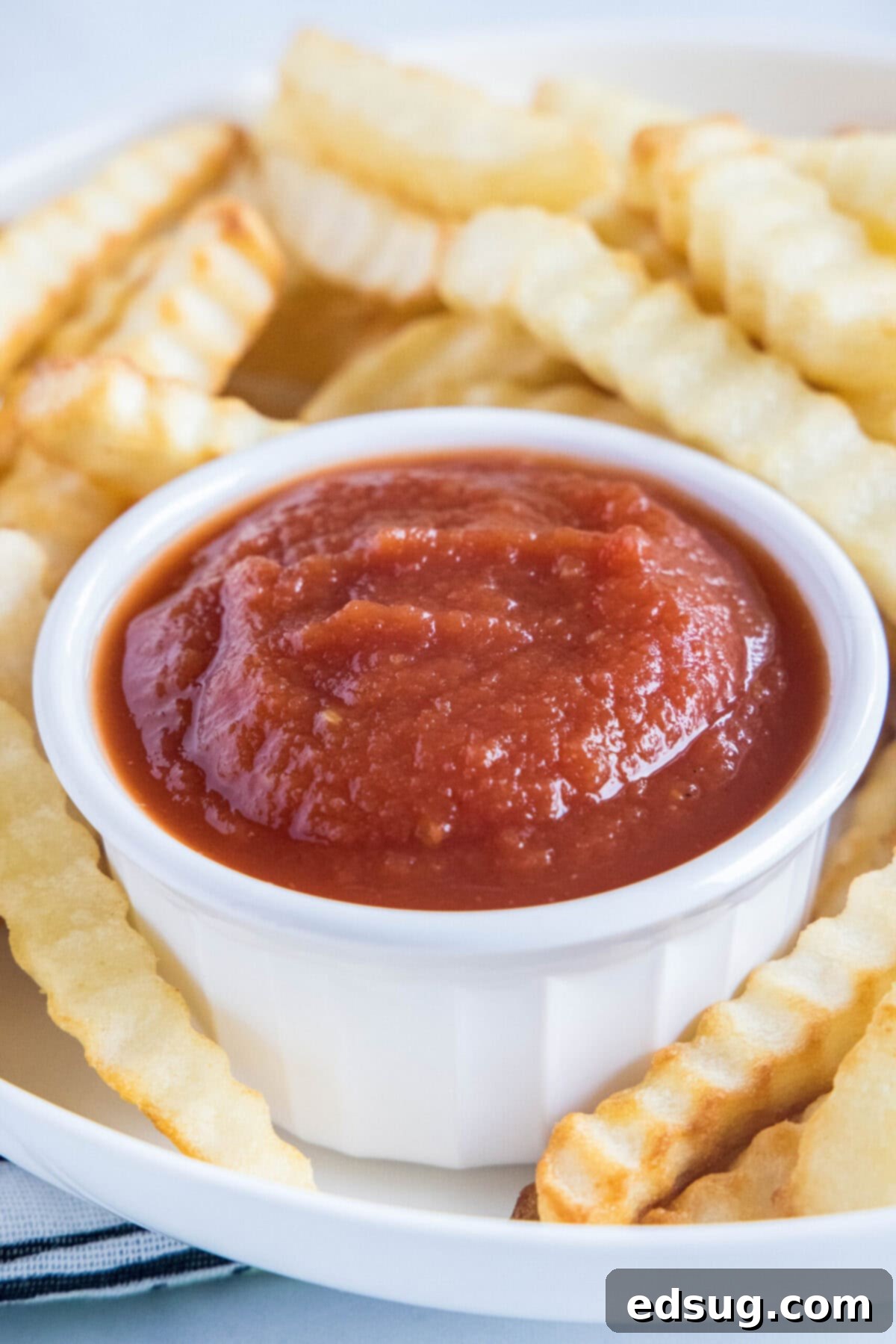
The true beauty of preparing your own ketchup lies in the unparalleled control you have over its ingredients. Do you prefer it less sweet? Simply reduce the amount of sweetener. Craving a bolder garlic presence? Feel free to add more! You can effortlessly adjust its thickness to your liking, experiment with different spice combinations, or even dial up the heat for a spicy kick. The possibilities for customization are endless, allowing you to create a ketchup that’s perfectly tailored to your personal taste preferences and culinary needs.
Why This Homemade Ketchup Recipe Will Become Your New Favorite
Once you experience the rich flavor and satisfying simplicity of this homemade ketchup, I’m confident you’ll find yourself keeping a fresh batch in your fridge at all times. Here’s an in-depth look at why this recipe stands out as truly exceptional:
- Effortlessly Easy: The idea of making ketchup from scratch might sound daunting or overly complicated, but I assure you, it’s surprisingly straightforward. You’ll only need eight common pantry staples, ingredients you likely already have on hand. From start to finish, the entire process takes less than an hour, making it a perfect project for a busy afternoon or even a weeknight. No fancy equipment or obscure techniques required!
- Unmatched Flavor & Superior to Store-Bought: This isn’t just “good for homemade” ketchup; it’s genuinely better than most store-bought options. The flavor profile is significantly stronger, richer, and more complex. While I appreciate the convenience of bottled ketchup, this homemade version offers an authentic tomato taste that sings with fresh acidity and a subtle sweetness, far removed from the sometimes-artificial or overly sugary taste of commercial brands. It’s a noticeable upgrade that truly enhances your meals.
- Impressive & Delightfully Unique: In a world accustomed to mass-produced condiments, serving homemade ketchup is a delightful surprise. Most people never even consider making ketchup themselves, so presenting your own creation is sure to elicit impressed remarks from friends and family. I’ve consistently found that people are not only intrigued when I mention I made my own ketchup, but they’re utterly blown away once they taste its exceptional quality. It’s a small touch that makes a big impact.
- Fully Customizable to Your Palate: One of my biggest frustrations with store-bought ketchup is its rigid flavor profile. Sometimes it’s too sweet, sometimes too salty, or lacking in acidity, often just plain boring. This recipe empowers you to be the chef. You can easily tweak the sweetness, spice level, and acidity to craft a ketchup that perfectly aligns with your cravings. Want a touch of smokiness? Add some smoked paprika. Prefer a little heat? A pinch of cayenne pepper will do the trick. This flexibility means your ketchup will always be exactly the way you like it.

Essential Ingredients for Your Homemade Ketchup
Gathering the right ingredients is the first step to creating this exceptional condiment. The beauty of this recipe lies in its reliance on easily accessible items, many of which are likely already in your kitchen. For precise measurements, please refer to the comprehensive recipe card located at the bottom of this page. Here’s a breakdown of what you’ll need:
- Canned Tomatoes: The foundation of any great ketchup. Opt for high-quality crushed or petite diced tomatoes. These forms break down beautifully during cooking and blend into a smooth consistency, ensuring a rich, robust tomato base.
- Water: Used to help achieve the desired consistency during the initial cooking phase before reduction.
- Sugar: Provides the essential sweetness that balances the acidity of the tomatoes and vinegar. You can adjust the amount to suit your preference.
- Distilled White Vinegar: Crucial for that characteristic tangy kick that defines ketchup. It also acts as a natural preservative, extending the shelf life of your homemade creation.
- Salt: A fundamental seasoning that enhances all the other flavors. Remember, it’s easier to add more salt later than to remove it, so start with the recommended amount.
- Onion Powder: Adds a savory, aromatic depth without the texture of fresh onion, contributing to the smooth finish.
- Garlic Powder: Delivers a mellow, savory garlic flavor that complements the tomatoes and spices beautifully.
- Black Pepper: For the best and freshest flavor, I highly recommend using freshly cracked black pepper. It provides a subtle warmth and a gentle kick that elevates the overall taste.
Step-by-Step Guide: How to Make Homemade Ketchup
You’ll be amazed at how simple and quick it is to prepare this delicious ketchup. In less than an hour, you’ll have a batch of homemade goodness ready to enjoy. Follow these straightforward steps:
- Combine the Ingredients: Begin by adding all of your measured ingredients into a sturdy saucepan. Stir everything thoroughly until well combined. This ensures that all the flavors will meld together evenly as the mixture cooks.

- Bring to a Boil: Place the saucepan on your stove over medium-high heat. Allow the mixture to come to a rolling boil. This initial high heat helps activate the flavors and kickstarts the cooking process.
- Simmer and Reduce: Once boiling, reduce the heat to a low simmer. Let the ketchup gently cook for approximately 40-45 minutes. During this time, stir occasionally to prevent sticking and ensure even cooking. The goal is for the ketchup to thicken considerably and reduce by about half, concentrating its rich flavors. You’ll notice a significant change in consistency and color as it cooks down.
- Achieve Smoothness with Blending: Once the ketchup has reached the desired thickness, remove it from the heat. For a perfectly smooth texture, use a stick blender directly in the saucepan. If you don’t have a stick blender, carefully transfer the hot ketchup to an upright blender or a food processor. Blend until it’s completely smooth, without any noticeable chunks. Exercise caution when blending hot liquids.
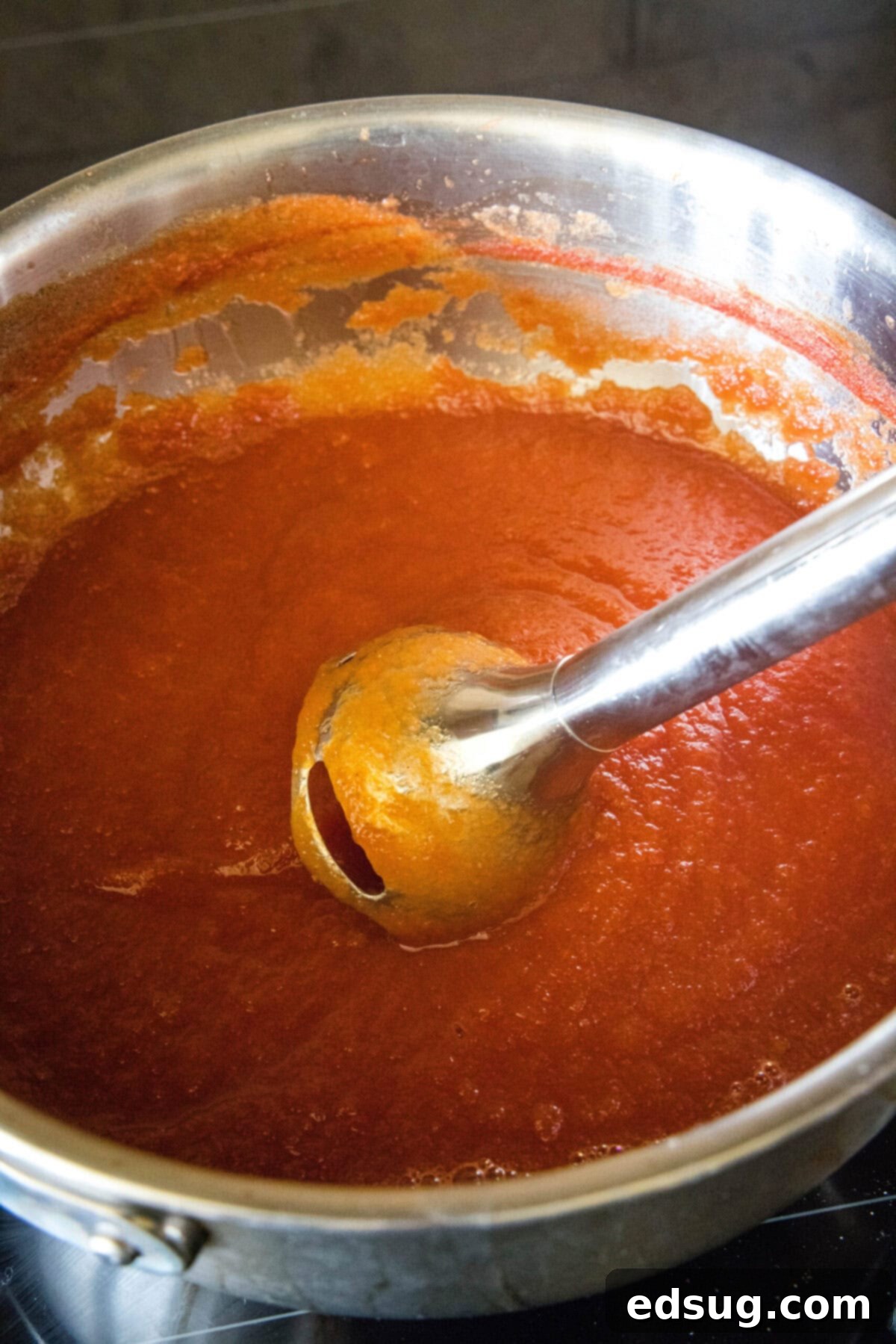
- Chill for Optimal Flavor: Allow the homemade ketchup to cool completely to room temperature. Once cooled, transfer it to an airtight container and store it in the refrigerator. Chilling not only preserves it but also allows the flavors to deepen and fully meld, resulting in an even more delicious condiment.
Expert Tips & Customization Tricks for Perfect Ketchup
Making homemade ketchup is a rewarding experience, and these tips and tricks will help you achieve perfection every time, allowing you to tailor the recipe to your exact preferences:
- For Unparalleled Smoothness, Consider Cheesecloth: While many blenders do an excellent job of pureeing, some might leave your ketchup slightly grainy. If you desire a truly silky-smooth, store-bought-like texture, here’s a professional trick: line a fine-mesh strainer with a few layers of cheesecloth and place it over a large bowl. Carefully pour the blended ketchup through the cheesecloth-lined strainer. You’ll need to use the back of a spoon or a spatula to gently push and force the ketchup through the cloth. This extra step removes any tiny tomato solids or seed fragments, yielding an incredibly smooth, restaurant-quality condiment.
- Master the Art of Thickness: The ideal thickness of ketchup is a matter of personal preference, and it can also vary based on your stove’s heat, the cooking duration, and the type of canned tomatoes used. If, after blending, your ketchup appears too thin for your liking, simply return it to the saucepan over low heat. Continue to gently simmer and stir until it reduces further and thickens to your desired consistency. Conversely, if it turns out too thick, gradually stir in a tablespoon or two of water until it reaches that perfect pourable texture. Always add liquids sparingly and taste as you go.
- Salt with Caution and Taste as You Go: It’s easy to inadvertently over-salt ketchup, especially since the flavors concentrate significantly as the sauce reduces. To avoid this common pitfall, I recommend starting with a conservative amount of salt as specified in the recipe. Once the ketchup has finished simmering and blending, give it a taste test. At this point, you can add additional salt in small increments, stirring well after each addition, until it reaches your ideal savory balance. This “taste and adjust” method ensures your ketchup is perfectly seasoned.
- Explore Spice Variations: Don’t be afraid to experiment beyond the basic spices. A pinch of smoked paprika can add a wonderful depth and smoky note. For a bit of heat, a tiny amount of cayenne pepper or a dash of hot sauce stirred in at the end can transform it into spicy ketchup. A touch of allspice or ground cloves can also give it a more traditional, slightly sweet and pungent profile, reminiscent of classic ketchup recipes.
- Sweetener Alternatives: While granulated sugar is traditional, you can explore other sweeteners. Honey or maple syrup can lend a different nuance of sweetness and a slightly richer body. Remember that liquid sweeteners might subtly affect the final consistency, so you might need to adjust cooking times slightly to achieve the desired thickness.
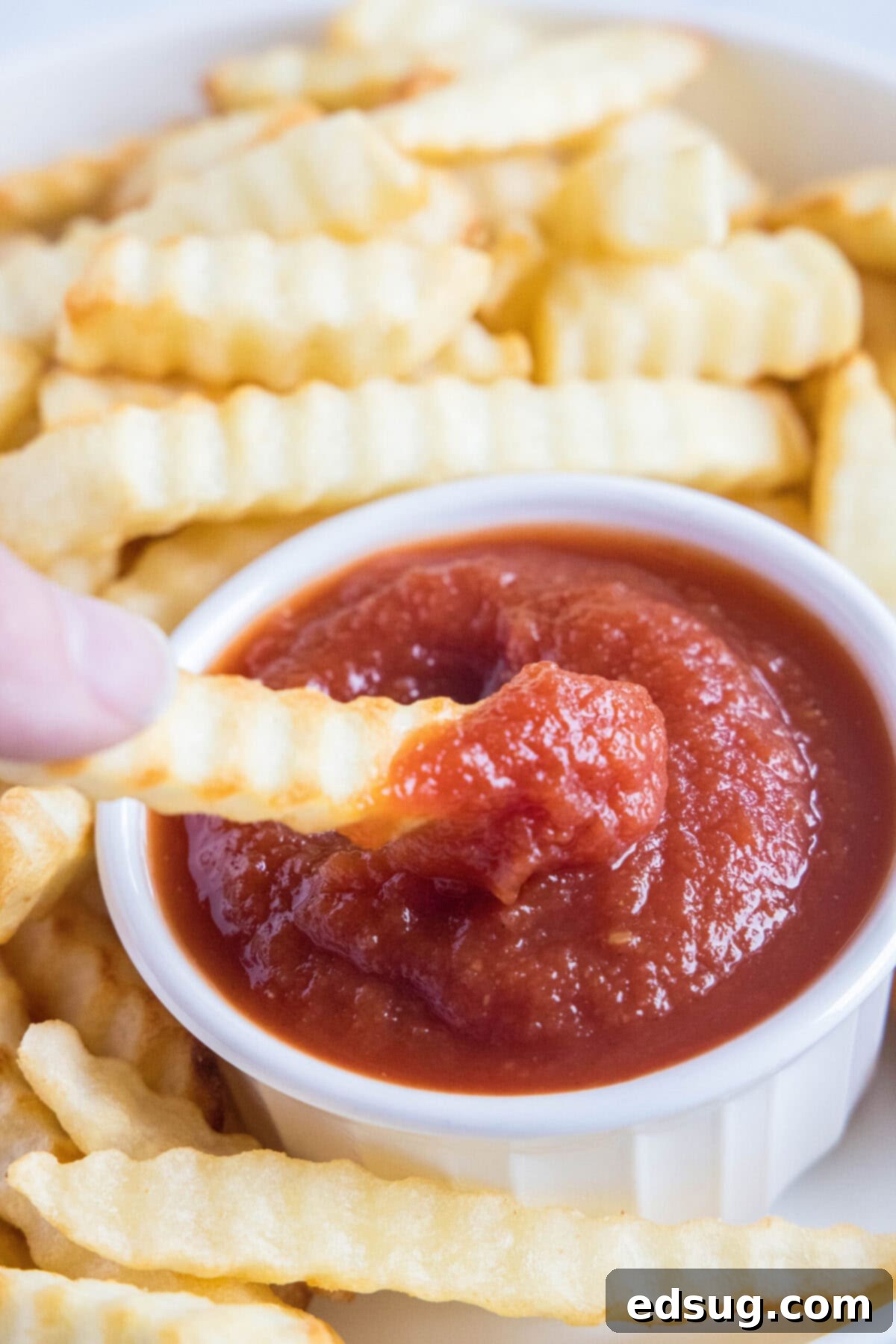
Delightful Ways to Serve Your Homemade Ketchup
Once you’ve whipped up a batch of this fantastic homemade ketchup, the immediate question becomes: what to dip into it first? Its superior flavor means it pairs wonderfully with a wide array of dishes, elevating everyday meals into something special. Here are some of my all-time favorite ways to enjoy it:
- Crispy Air Fryer Frozen French Fries: The classic pairing! The tangy, sweet ketchup perfectly complements the salty crunch of fresh or air-fried fries.
- Golden Air Fryer Onion Rings: A delicious alternative to fries, these sweet and savory rings are heavenly when dipped in rich homemade ketchup.
- Juicy Chick-Fil-A Grilled Nuggets: A healthy and flavorful option that becomes even more irresistible with a generous dollop of your homemade condiment.
- Hearty Arby’s Beef & Cheddar Sandwich (Homemade Version): Elevate your sandwich experience with a spread of this flavorful ketchup; it cuts through the richness beautifully.
- The Best Classic Hamburgers: No burger is complete without ketchup, and homemade truly makes all the difference in a simple, classic burger.
- With Eggs and Breakfast Burritos: Add a zesty kick to your morning eggs, whether scrambled, fried, or folded into a breakfast burrito.
- On Hot Dogs and Sausages: A staple for any picnic or BBQ, homemade ketchup transforms a simple hot dog into a gourmet delight.
- As a Base for BBQ Sauce: Use it as a starting point for your own signature BBQ sauce, adding other ingredients like Worcestershire, mustard, and brown sugar.
- In Meatloaf or Meatball Glazes: Incorporate it into your favorite meatloaf recipe or use it to create a tangy glaze for meatballs.
Storing Your Delicious Homemade Ketchup
Another fantastic advantage of this homemade ketchup recipe is its impressive shelf life. Thanks to the natural preserving qualities of vinegar and the cooking process, you can easily store any leftovers. Simply transfer your cooled ketchup into a clean, airtight container – a glass jar works perfectly – and it will remain fresh and flavorful in your refrigerator for at least an entire month, if not longer. This makes it ideal for meal prepping or always having a superior condiment on hand.
Can You Freeze Homemade Ketchup? Absolutely!
Yes, you can absolutely freeze any leftover homemade ketchup, making it an excellent option for batch cooking. To ensure the best quality upon thawing, first make sure the ketchup has cooled completely to room temperature. Then, transfer it to an airtight, freezer-safe container. It will keep beautifully in the freezer for up to four months. When you’re ready to use it, simply thaw it overnight in the refrigerator. You might notice a slight change in consistency after defrosting; a quick stir or a brief re-blend in a food processor will bring it back to its smooth, original texture.
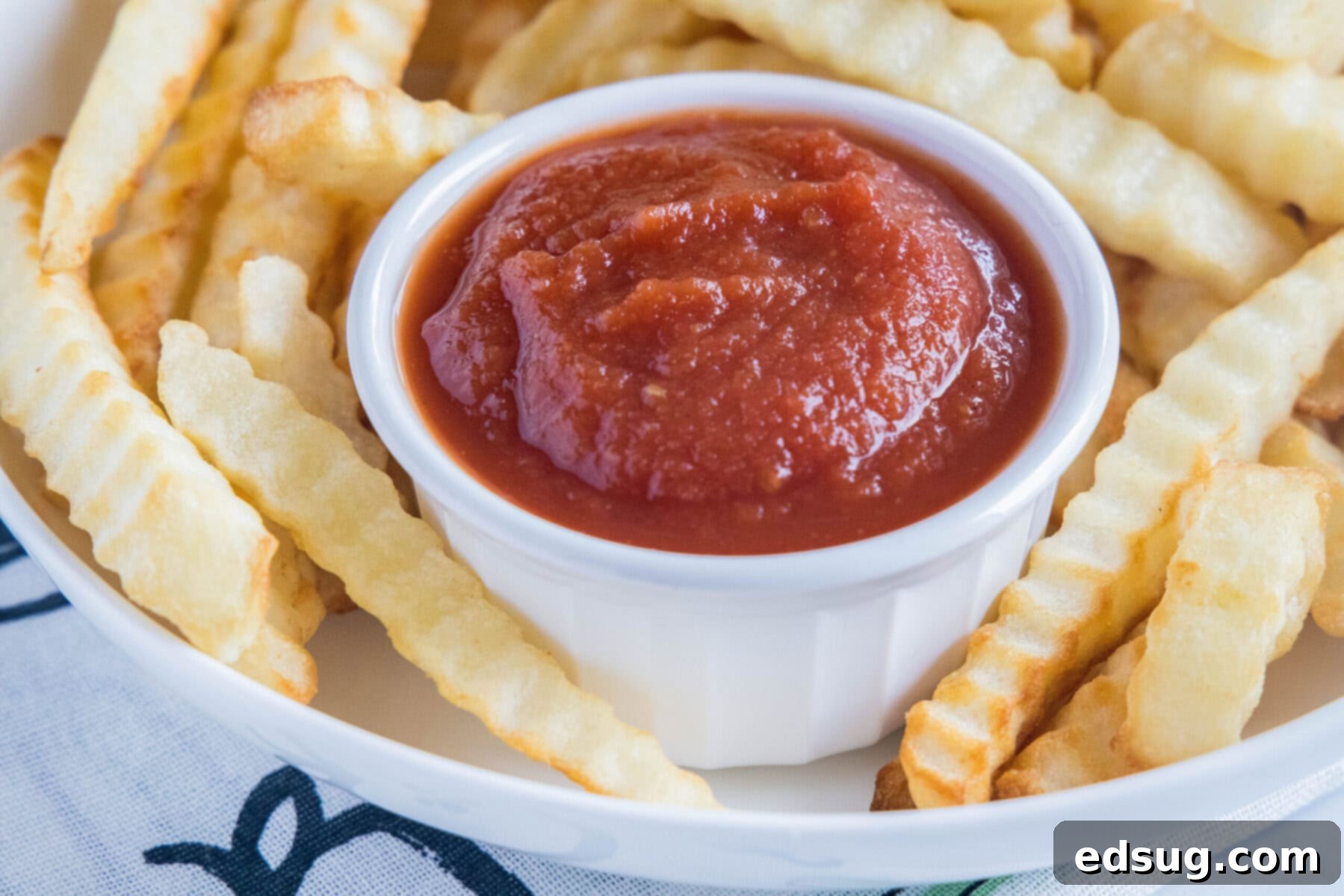
Discover More Easy Homemade Sauces and Dips
Once you experience the satisfaction of creating your own condiments, you might find yourself eager to explore other homemade options. Expanding your repertoire of sauces and dips is a fantastic way to elevate your cooking and add fresh, vibrant flavors to every meal. Here are some of my other favorite, easy-to-make recipes that I highly recommend trying:
- Copycat Raising Cane’s Sauce: A creamy, tangy, and slightly spicy dipping sauce that’s perfect for chicken fingers or fries.
- Luxurious Roasted Garlic Cream Sauce: An incredibly versatile and flavorful sauce that pairs wonderfully with pasta, chicken, or vegetables.
- Refreshing Tzatziki Sauce: A cool, cucumber and yogurt-based dip, ideal for grilled meats, pita bread, or as a fresh accompaniment.
- Zesty Spicy Cajun Dipping Sauce: For those who love a bit of heat, this sauce adds a fantastic kick to seafood, chicken, or even roasted potatoes.
- Copycat Red Lobster Tartar Sauce: A creamy, dill-infused classic that’s a must-have for any fish and chip night.

Homemade Ketchup Recipe
Pin Recipe
Rate Recipe
Print Recipe
Ingredients
- 1 28 oz can crushed or petite diced tomatoes
- 1/4 cup water
- 1/3 cup sugar
- 1/3 cup distilled white vinegar
- 1 teaspoon salt
- 1/2 teaspoon onion powder
- 1/2 teaspoon garlic powder
- 1/4 teaspoon black pepper
Instructions
-
Add all of the ingredients to a saucepan and mix together thoroughly until well combined.1 28 oz can crushed or petite diced tomatoes, 1/4 cup water, 1/3 cup sugar, 1/3 cup distilled white vinegar, 1 teaspoon salt, 1/2 teaspoon onion powder, 1/2 teaspoon garlic powder, 1/4 teaspoon black pepper
-
Place the saucepan over medium-high heat and bring the mixture to a full boil.
-
Reduce the heat to low and let the ketchup simmer gently for 40-45 minutes, stirring occasionally. Continue cooking until it has thickened significantly and reduced by approximately half.
-
Using a stick blender directly in the pot, or by carefully transferring to a food processor or standing blender, puree the ketchup until it is completely smooth. If you find the ketchup is too thin after blending, return it to low heat and simmer briefly, stirring, until it reaches your desired thickness.
-
Allow the homemade ketchup to cool completely to room temperature. Once cooled, transfer it to an airtight container and store in the fridge until ready to serve.
Notes
- Leftovers can be stored in an airtight container in the fridge for at least a month.
- For longer storage, homemade ketchup can be frozen in an airtight container for up to 4 months. Thaw overnight in the fridge and stir or re-blend if needed after defrosting.
- For an exceptionally smooth, restaurant-quality texture, strain the blended ketchup through a fine-mesh strainer lined with cheesecloth.
- Always taste and adjust seasoning, especially salt, after the ketchup has cooked down and blended.
Nutrition Information (per serving)
Nutrition information is automatically calculated and provided as an approximation only. Please consult a professional for precise dietary advice.
Additional Recipe Details
Did you love this recipe? Share your thoughts below!Your feedback helps us improve and inspires others to try it too!
I’ve cultivated a vibrant community on Facebook, and I’d be absolutely thrilled for you to join us! It’s a welcoming space where you can
share YOUR favorite recipes, ask questions, exchange cooking tips, and stay updated on all the exciting new content at Dinners, Dishes and Desserts, ensuring you never miss a new recipe or culinary inspiration!
Be sure to follow me on Instagram and
tag #dinnersdishes so I can see all the wonderful creations and delicious meals YOU make from Dinners, Dishes, and Desserts recipes!
Stay connected and be the first to know about new recipes, cooking adventures, and more!
Facebook | Twitter | Pinterest | Instagram
